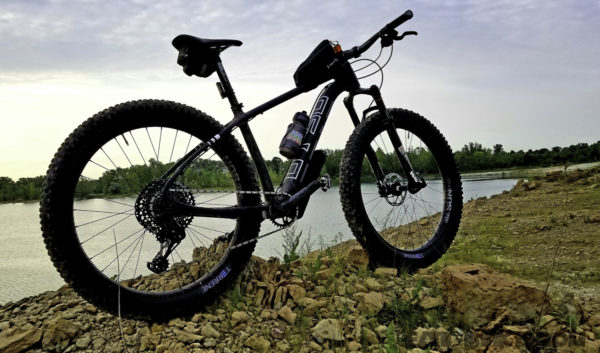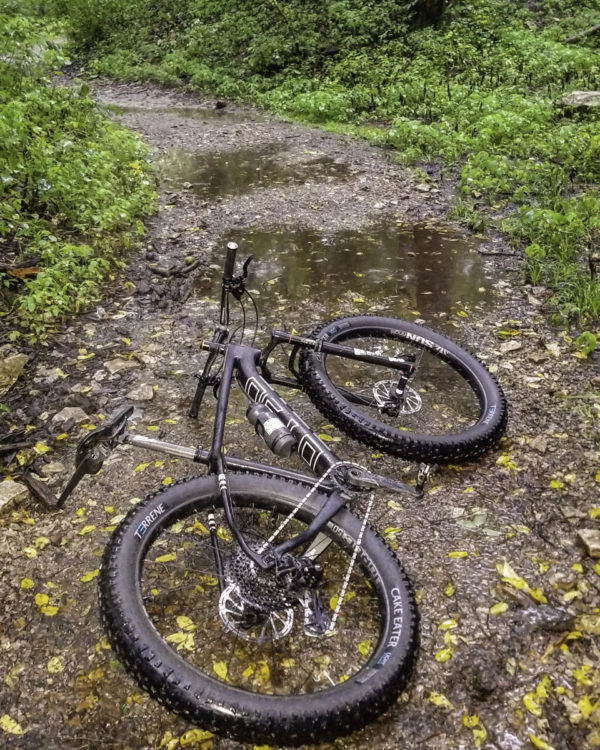Back in July, we received a beautiful Otso Voytek Plus-Fat rig for review. If you missed the introduction and specs, you can find that post here: https://fat-bike.com/2018/08/first-look-otso-voytek-plus-fat-rally-sport-by-seth-bell/
Now that Summer is officially in the rear-view and the crisp days of Autumn are here (my favorite!), we wanted to share with you what a few months of mountain biking aboard the Voytek have been like. The concept behind Otso’s Plus-Fat build is a basic but elusive one that keeps some riders up late at night: having one bike to do it all; in this case a mountain bike and fat-bike in one package by simply swapping tires.
While I’m no stranger to swapping tires around, riding the Voytek did introduce several first-time experiences for me. Our Plus-Fat build came rolling on 27.5 x 50mm Sun Duroc rims with a pair each of Terrene’s McFly 2.8” and Cake Eater 4.0”. Aside from short test rides, I had never spent any real time riding a 27.5” wheel, and this was my first experience with Terrene tires. The Sram Eagle GX drivetrain and Magura M4 brakes were also bits that I’ve seen and worked on but never had a chance to put any real time on.
The Voytek took a good week of riding to get the fit and feel just right; there was a lot of stem swapping and tire pressure fussing. I started off testing with the Cake Eaters since my usual mountain bike rolls on 26 x 4.0” tires and I wanted to keep a similar size under me while getting to know the new bike.
Once dialed in and pointed down the singletrack the Voytek came to life… this bike rips! Even with the Cake Eaters on there is room in the rear triangle to keep the ‘Tuning Chip’ in the forward position, giving the bike a short and sporty 430mm chainstay. Acceleration is snappy, and lofting over log piles and other obstacles is a breeze. The Voytek corners like a scared cat but never feels twitchy or over-reactive. Going uphill the Otso feels light and efficient, but I did notice the slacker front end did tend to wander just smidge during some seated, low speed – high torque climbing efforts. Overall the ride quality of the Voytek is fantastic; more smooth and refined feeling over other carbon hardtails I’ve ridden, but never feels flexy or like there was any loss of efficiency.
The build kit on our test bike has performed very well with one small exception; the brake rotors. Never having used Magura brakes before, I was impressed by the smooth lever feel and modulation during my first couple weeks of riding. After that first couple of weeks, the brakes went from some ‘to be expected’ squeaking to a full-blown pulsating gobble, despite repeated efforts to clean and lightly sand the pads and heat-warped rotors. After swapping out the 160mm rotors for 180’s, the gobble has gone away and never returned. The Voytek is a proper trail bike capable of running some big rubber, so I think specing it with bigger rotors would be a small but meaningful improvement.
Speaking of the bike being able to run big rubber, let’s talk about the tires. The Terrene McFly measured to 2.75” wide by 2.36” tall inflated to 15 psi; the Cake Eaters come in at 3.54” wide and 3.15” tall inflated to 7.5 psi. At their smaller-than-labeled sizes, both sets of tires were respectively smaller than what I normally ride, making the Cake Eater seem to me like a ‘plus’ tire and the McFly just a ‘normal-for-2018 mountain bike tire’.
Both sets of Terrenes are good, fast, dry condition tires and handle similar conditions in similar fashions. During wet rides on greasy trails both tires packed up a fair amount, but the Cake Eaters seemed to retain a bit more grip and shed the mud faster than the McFlys. Both sets of tires dig into steep climbs better with the rear tire run in the ‘reverse’ direction. I’m a constant offender of pedaling through corners and am used to pedal strikes a couple times a ride. With the bigger hoops and Cake Eaters I rarely ever clip a pedal but do with more regularity when running the smaller McFlys.
While there is plenty of dirt to be found on our local selection of trails, there are also some extremely rocky areas around pits that used to be quarried by a cement company. The shifty rock trails are where the higher volume Cake Eaters won my confidence over the McFlys. The Cakes let me bomb and rip through the rough stuff where the McFlys had me getting kicked off my line here and there.
The Voytek certainly feels like two distinctly different bikes depending on which set of tires you’re running. As a ‘Plus-bike’ with the 2.8” McFlys my experience with the bike was a bit lukewarm and reminded me why I haven’t ridden a ‘regular’ mountain bike in a long time. #notplusenough
In ‘Fat-bike’ mode using the Cake Eaters, Otso’s Voytek is hands down the most fun I’ve ever had riding a hardtail, and never left me yearning to go back to my full suspension bike. The Duroc’s skinny 50mm waistline pair nicely with the Cakes, making them into a not-quite-fat 3.5” tire that is faster than my usual fat-bike set up, but far more forgiving and confidence inspiring than running a 2.8” tire.
If I had to have only one bike for singletrack duties, I could live happily ever after with the Voytek rolling on Cake Eaters, but will the same be true in regards to having only one bike for the Winter? For riders in some parts of the globe, this build would certainly suffice as both plus-bike and fat-bike, especially places that snow isn’t a paramount consideration.
The smaller footprint and sporty ride that I love about the Voytek in ‘Fat’ mode as compared to my other fat-bikes does give me some reservations about there being enough tire volume for snow use. I don’t foresee much of an issue on hard packed snow, but breaking trail after a few fresh inches or trying to stay afloat on freshly groomed ski/snowshoe trails might be difficult. Lighter weight riders may find that this set-up provides enough flotation for soft conditions, but riders in the 180+ lb category will probably find better buoyancy with wider 70-85mm rims and 27.5 x 4.5 tires. It’s nice to have choices and the Voytek provides a great platform for a wide range of rim width/diameter wheel compatibility.
I wish that I could keep the Voytek longer, but three months is almost twice as long as fat-bike.com normally tests at fat-bike, so Tio Gomez made me box the Voytek up and return it back to Otso. The fact that returning this bike makes my head hurt, speaks to how much that I like the way that the Voytek (with the Cake Eaters) rides. So that’s the end of our look at the Osto in Plus/Fat Mode. The bottom line…..If I could afford it, I’d buy one.
Thanks for reading; we’ll see you out there! – SB.









I would like to see you do a test using a Fatbike with light (maybe carbon) 26x65mm rims and a light fast-rolling 26×3.8-4.0in tire for summer trail riding and then switch to 26×4.8-5.0in tire for winter snow. I think that combination would make a good four-season bike.
There’s an XS 9:Zero:7 in my Garage that rocks a set of drilled out marge lites (65mm wide) with a Bontrager Rougarou 26×3.8 in the rear and a Vitoria Bomboloni 26×4.0 up front for summer that gets a Surly – Bud (F) – Nate (R) mounted for winter snow riding. It’s a great setup for riders that are less than 180lbs.